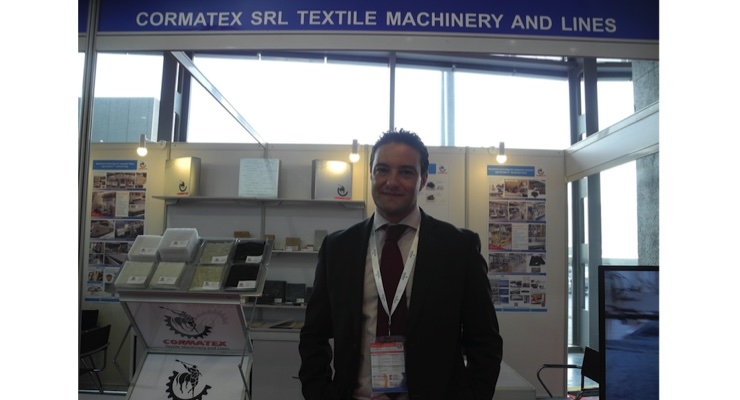Cormatex Launches Airlaid Technology
11.09.17
Vertical airlaid and horizontal airlaid machines are being presented at booth 1W11
At SINCE, Cormatex is presenting its two new airlaid technologies - the vertical airlaid machine and the horizontal airlaid machine.
Luca Querci, sales manager, Cormatex, explained both of the technologies for in detail. For the vertical airlaid, by inserting the fiber vertically, the materials are characterized by special resiliency, very high loft and are very good for applications such as mattresses, car seats, and applications that need thermal and acoustic insulation. “Our vertical airlaid technology achieves perfect vertical orientation of the fibers. In addition, this technology is really flexible, and can process almost any recycled materials that come from different industries, textiles or mattresses, PU foam, and both fibers and non-fibers can be recycled.”
The horizontal airlaid technology is similar to the vertical airlaid machine in the dynamic web forming system, but the orientation of the fiber is perfectly horizontal. This gives the materials better mechanical properties, such as higher tensile strength, and allows very lightweight products down to 100gsm. It also can be combined with the needlepunching process and can achieve results as desired.
“Recently we developed products on our horizontal airlaid machine with carbon fiber and glass fiber. These fibers are very difficult to be processed or needlepunched, but we achieved very interesting results in terms of mechanical properties,” says Querci.
According to Querci, the other advantages of the horizontal airlaid is that it can use powder resin like epoxy resin and phenolic resin as a binder, and the process is very clean, only needing little maintenance, and the products provide very high stiffness and flame retardancy.
Since the machine first exhibited in China at the last ITMA in Asia, the company has already had one line installed in China, using recycled garments to make mattresses and acoustic materials for automotives. Now, the client is starting to use vegetable fibers such as bamboo fibers and coconut fibers to produce industrial, automotive and bio-composite materials.
Querci adds, “The second line will be installed next year. It’s an interesting market, and we would expect four to five projects in China next year.”
Luca Querci, sales manager, Cormatex, explained both of the technologies for in detail. For the vertical airlaid, by inserting the fiber vertically, the materials are characterized by special resiliency, very high loft and are very good for applications such as mattresses, car seats, and applications that need thermal and acoustic insulation. “Our vertical airlaid technology achieves perfect vertical orientation of the fibers. In addition, this technology is really flexible, and can process almost any recycled materials that come from different industries, textiles or mattresses, PU foam, and both fibers and non-fibers can be recycled.”
The horizontal airlaid technology is similar to the vertical airlaid machine in the dynamic web forming system, but the orientation of the fiber is perfectly horizontal. This gives the materials better mechanical properties, such as higher tensile strength, and allows very lightweight products down to 100gsm. It also can be combined with the needlepunching process and can achieve results as desired.
“Recently we developed products on our horizontal airlaid machine with carbon fiber and glass fiber. These fibers are very difficult to be processed or needlepunched, but we achieved very interesting results in terms of mechanical properties,” says Querci.
According to Querci, the other advantages of the horizontal airlaid is that it can use powder resin like epoxy resin and phenolic resin as a binder, and the process is very clean, only needing little maintenance, and the products provide very high stiffness and flame retardancy.
Since the machine first exhibited in China at the last ITMA in Asia, the company has already had one line installed in China, using recycled garments to make mattresses and acoustic materials for automotives. Now, the client is starting to use vegetable fibers such as bamboo fibers and coconut fibers to produce industrial, automotive and bio-composite materials.
Querci adds, “The second line will be installed next year. It’s an interesting market, and we would expect four to five projects in China next year.”


